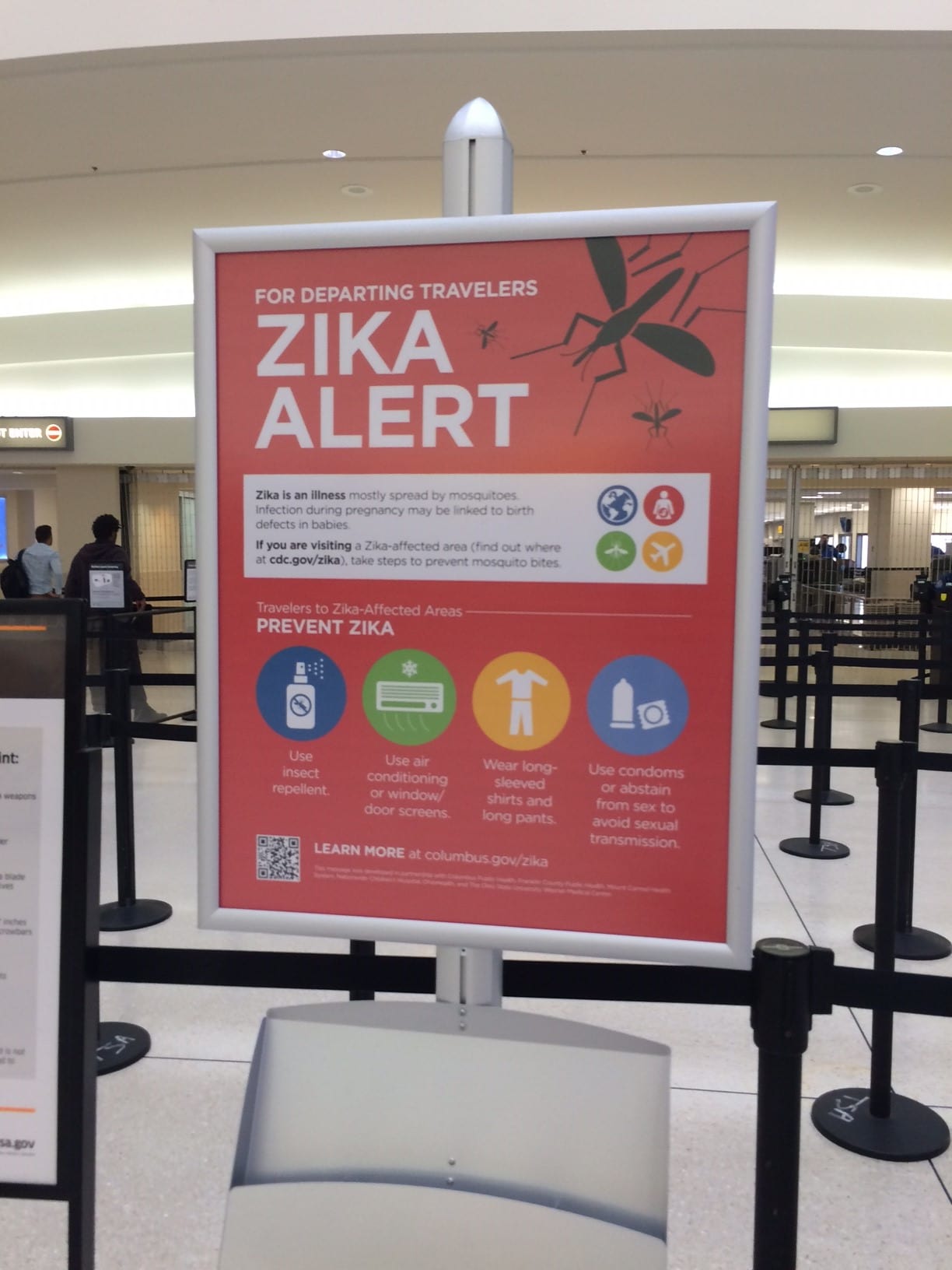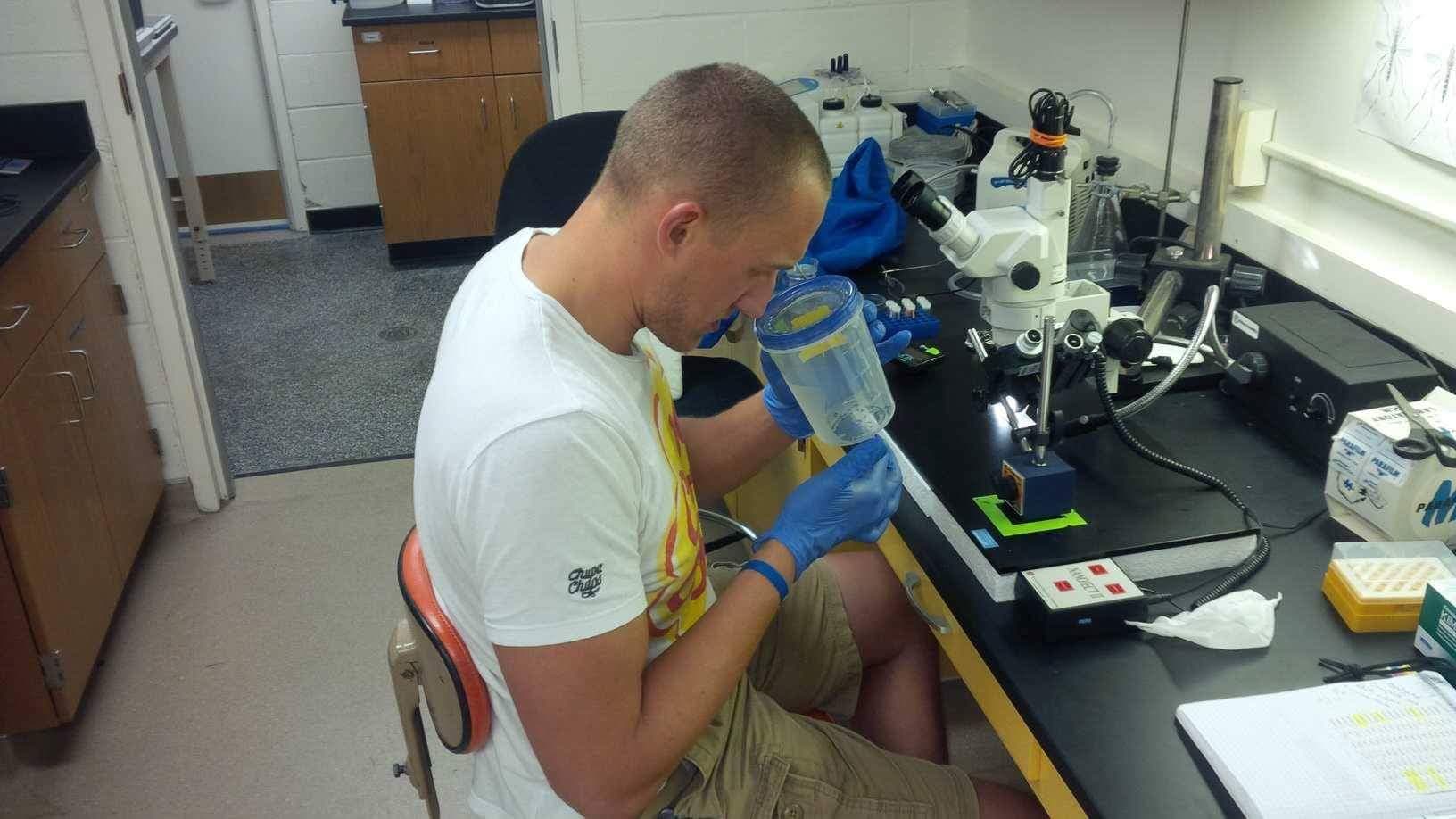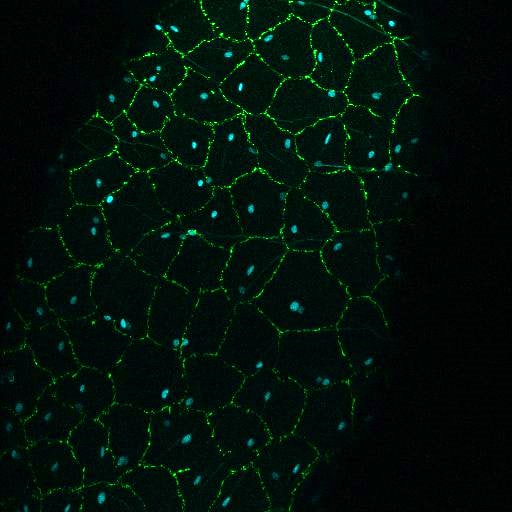Fourth Update: Thank you for your support!
We are getting down to the last day of our fund-raising period (June 30th) and wanted to thank all of our donors for their generous contributions! We have been making great progress with our research this month thanks to your support and our team is looking forward to continuing this work throughout the rest of the summer. Mosquito season will soon hit its peak in July and August, so please take precaution to avoid being bitten (e.g., wear repellents), especially when traveling to countries where there is active transmission of Zika virus, and we will do our best to find new ways of controlling the 'most dangerous animal on the planet'. Thanks to Carol Anelli for providing the photo below that was taken today 6/29 at the Columbus airport.
Feel free to keep spreading the word of our project today and tomorrow and hopefully we can garner a few more last minute donations to get closer to our goal: https://buckeyefunder.osu.edu/project/2321

Third Update: Understanding the biological roles of new genes and proteins in mosquitoes
Thanks again to everyone who has supported the project! We are coming down the home stretch for our fund raising period, so please keep spreading the word as we approach the end. In this third update, we wanted to feature some of the work being performed by Mr. Travis Calkins (a PhD candidate; first photo below) and Ms. Jasmine Cruz (a summer researcher from the OSU Summer Research Opportunities Program; second photo below). They are trying to understand the biological roles of a family of proteins in mosquitoes called 'innexins' that allows mosquito cells to 'talk' to one another. It may sound obscure, but these proteins are found only in insects and other invertebrate animals, which makes them potentially attractive as an insecticide target, because a chemical that interrupts their function is expected to have very little impact on humans and other mammals. However, we first need to understand what biological roles these proteins play in mosquitoes. Travis has been studying these proteins for the past 4 years as part of his graduate program, trying to understand what roles they play in mosquito digestion, excretion, and reproduction. One aspect of understanding the function involves visualizing where the protein is found in the mosquito, which is what Jasmine and Travis have been focusing on this month. The third image below shows you a picture from a microscope that Travis and Jasmine captured from the mosquito digestive tract (third photo below). The protein they are interested is shown in green and forms a snakeskin like pattern, which represents the edges of cells that are 'talking' to one another. If we can disrupt this form of communication then mosquitoes may have a harder time digesting any blood they take from us and thereby produce fewer eggs, which could lead to a novel method for mosquito control. We will hopefully find out thanks to your support!
We thank you again for your support and would greatly appreciate it if you could please keep spreading the word of our project to others in your contact lists and social networks so that we can reach our goal: https://buckeyefunder.osu.edu/project/2321



Second Update: Discovering new natural repellents and insecticides for mosquito control
Thanks again to everyone for their generous donations! In our second update, we wanted to feature some of the work being performed by Ms. Edna Alfaro ( a visiting scholar from El Salvador; on the left in first picture below) and Ms. Margot Shaya (a recent Wooster High School graduate; on the right in the first picture below). This summer they are attempting to identify new natural-based repellents and insecticides from plants for controlling mosquitoes. In case you didn't realize it, the best way to avoid contracting a mosquito-borne disease such as West Nile and Zika is to avoid being bitten by a mosquito. Easier said than done! Some of the tools we have to help us are repellents (e.g., DEET, an active ingredient in 'OFF') and insecticides, which keep mosquitoes away from us and kill mosquitoes, respectively. However, DEET is a very strong chemical that some people find irritating to their skin (and its long term exposure effects are not well known) and can melt plastics, and mosquitoes are becoming resistant to many insecticides (similar to how bacteria become resistant to antibiotics). Thus, there is a lot of interest and need for developing new repellents and insecticides to keep mosquitoes away from us!
Both Edna and Margot are testing out a series of plant compounds as potential repellents and insecticides. The compounds are provided to us by our collaborator Dr. Liva Rakotondraibe who is an assistant professor in the College of Pharmacy at The Ohio State University. Liva is an expert at discovering new potential drugs from natural sources to combat cancer, malaria, and other important diseases and he is now taking the fight to mosquitoes! Edna and Margot have recently discovered that if you place some of Liva's compounds right next to a source of blood the mosquitoes are so irritated by it that they will not feed on the blood, suggesting they may be good repellents (i.e., if you placed such a molecule on your skin then the mosquitoes would avoid you). In addition, when you directly apply this compound to mosquitoes they die within 24 h, suggesting that they may be good insecticides as well. A lot of chemicals have potential to repel or kill mosquitoes (as well as humans!), but we are so interested in Liva's molecules because they are natural products from plants that are known to be ingested by humans as cultural remedies or spices. So, they are likely to not be very toxic or irritating to humans and could potentially be developed into 'organic' mosquito repellents/insecticides.
The second picture below shows you some mosquitoes (Aedes aegypti, a vector of Zika virus) in a cage that Edna and Margot prepared for a blood feeding experiments. The third picture shows you an experiment in action. The blood is held in the gray object sitting on top of the mesh screen that is covering the cage. The bottom of the gray object has a thin membrane that simulates skin. The mosquitoes pierce through this membrane to acquire the blood. In this experiment, Edna and Margot applied a plant compound to two of the membranes and a solvent control to one of them. Almost all of the mosquitoes in the control cage fed on blood while very few of the mosquitoes in the other cages fed on blood, suggesting the compound repelled them from the blood.
We thank you again for your support and would greatly appreciate it if you could please keep spreading the word of our project to others in your contact lists and social networks so that we can reach our goal: https://buckeyefunder.osu.edu/project/2321



First update: Mosquito trapping in Cleveland!
Thanks to everyone who has made a donation so far! We are very appreciative of the support and are excited to share a few updates with you on our progress. In this week's update, we wanted to feature work being performed by Ms. Liu Yang who is a Ph.D. candidate in the Piermarini lab. During the week of June 6th, Liu conducted field work in various neighborhoods of Cleveland, Ohio where she trapped mosquitoes to start monitoring for the presence of important disease vectors of West Nile, Zika, and encephalitis viruses.
The first image below shows Liu in front of one of her gravid traps, which is designed to attract female mosquitoes who have recently fed on blood. The mosquitoes are attracted to an concoction of guinea pig food (chow) dissolved in water and fermented in the sun for several days (and it smells as bad as it sounds). You can see this liquid concoction sitting in the bottom of the black container in the image. The mosquitoes find the odors from this 'soup' irresistible and attempt to lay their eggs in it, but as they get closer to the container they are sucked into the white netting by a small fan where they are trapped.
After setting these traps in morning/afternoon, Liu picks them up the following day and brings back the haul of mosquitoes to our lab in Wooster where she identifies them by species under the microscope. You can see a sample of what she captured under the microscope in the second picture below. So far, Liu has primarily found the species of mosquito that transmits West Nile virus, but not Zika virus. She will be sending these mosquitoes to the Ohio Department of Health to have them tested for the presence of West Nile virus to see if the mosquitoes were carrying this virus. If any of the mosquitoes test positive, then the public health agencies in Cleveland will be immediately notified so they can begin mosquito control measures in the affected neighborhoods.
We also wanted to take this opportunity to welcome Ms. Jasmine Cruz (3rd picture below) to our lab, who is a summer student in the OSU Summer Research Opportunities Program (SROP). In this program, Jasmine is obtaining some hands on experience with research in the Piermarini lab and learning about key professional development skills with her cohort of students. Jasmine helped Liu out last week with the mosquito trapping and you will hear more about her lab-based research project in a future update.
We thank you again for your support and would greatly appreciate it if you could please keep spreading the word of our project to others in your contact lists and social networks so that we can reach our goal: https://buckeyefunder.osu.edu/project/2321
Stay tuned for another update soon!



$5
Mosquito egg
Fun fact: Some mosquitoes lay dozens of individual eggs one at a time near or on a stagnant body of water. With this donation level, we can purchase basic supplies for maintaining colonies of mosquitoes we use in laboratory experiments (e.g., cages, sugar, cotton, netting).
$10
Mosquito egg raft
Fun fact: Some mosquitoes lay eggs in large clusters that stick together and float on the surface of water. With this donation level, we can purchase basic supplies needed for setting mosquito traps at our field sites (e.g., batteries to operate traps, dry ice for generating carbon dioxide).
$25
Mosquito larva
Fun fact: Mosquito larvae are juveniles that develop in stagnant water. They feed on microorganisms and organic matter. With this donation level, we can purchase animal blood from a supplier that we use to feed our mosquito colony and conduct experiments.
$50
Mosquito pupa
Fun fact: Once mosquito larvae grow large enough they transform into a pupa where they undergo metamorphosis into an adult mosquito. With this donation level, we can purchase fuel that is need to transport lab personnel and mosquito personnel to our field sites where we are trapping mosquitoes.
$100
Adult male mosquito
Fun fact: Adult male mosquitoes fly but do not feed on human blood or transmit disease. They only consume plant nectar. With this donation level, we can purchase mosquito traps that are needed for collecting mosquitoes from our field sites.
$250
Adult female mosquito
Fun fact: Adult female mosquitoes are the only life stage that feeds on human blood and transmits diseases. They need our blood to produce their eggs. With this donation level, we can purchase reagents and materials needed for conducting insecticide efficacy experiments on larval and adult mosquitoes.
$500
Engorged adult female mosquito
Fun fact: When mosquito feed on your blood they can ingest 2-3 times their own body mass in blood! Not so fun fact: When mosquitoes are feeding on you they also urinate on you! With this donation level, we can purchase supplies and materials needed for molecular biology experiments in which we are attempting to understand how certain genes play key roles in the biology of mosquitoes.
$1,000
Mosquito swarm
Fun fact: Some mosquitoes mate in swarms of thousands of individuals. Males are attracted to 'love songs' produced by the beating wings of females. With this donation level, we can purchase supplies and reagents that are necessary for testing mosquitoes captured in the field for the presence of infectious viruses (e.g., Zika, West Nile, dengue).






